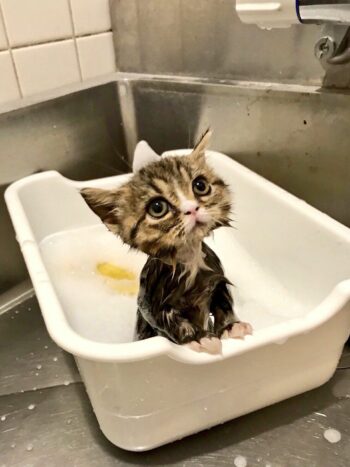Fortunately for those of us who love cats, we do not have to bathe a cat very often. They spend hours of their day using that scrub-brush tongue to clean all debris and dirt from their fur and skin. However, upon occasion such a duty becomes necessary. In that case, do you know how to bathe the cat?
In all my years of having cats, I have been extremely lucky, as I only had to give a cat a complete bath one time. When we lived in Kodiak, one of my two black cats, Loose Cat, got into a territory disagreement with an interloper.
Loose Cat chased the stranger off, right through an expanse of muddy, boggy land. When he returned home, he had an ugly mud coat.

Into the bathroom we went. Loose Cat got his first and last bath. He seemed to understand that I had to get all that mud off him, and he didn’t try to escape. However, he vocalized with a howl that started in a low register and escalated upward until it was an ear-splitting shriek.
What an excellent cat! Though he told me his displeasure, he endured the process, all the way to the rub-down with a warm, soft towel. I think he actually was grateful for the cleaning.
So, when it becomes necessary, do you know the best process for bathing your cat? Read on for some pointers.
These reasons might make a bath necessary:
1) Getting sprayed by a skunk
Check the reference at the end of this post for ccspca.com. They include the following recipe for removing skunk smell:
- Stir together one teaspoon liquid dishwashing soap (ccspca recommends blue Dawn), 1/4 cup baking soda, 1 liter white vinegar. This remedy is strong enough to work, but not harmful, like peroxide, which can bleach kitty’s fur and skin. (You might prefer to purchase a shampoo soap designed for cats.)
- Gently rub this mixture into kitty’s fur. Don’t let it get in the eyes or ears. Rinse thoroughly with water.
2) If your cat gets overly dirty or stinky
Do you want your cat to lick off all that stuff and then ingest it? There could be toxic substances in there. A bath might become a better solution.
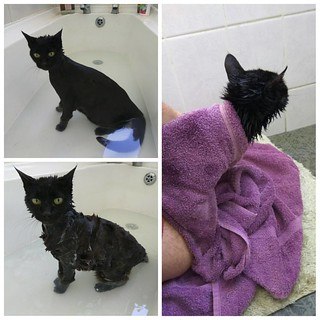
3) Remove bugs in his fur
If you can catch such infestations such as fleas, mites, ticks, or lice early enough, a bath can remove much of the problem. However, if the little pests are digging in, it would be a help to see your vet.
4) Cats with especially long hair
Often the cat can not handle keeping the fur clean, and could use a bit of help from you. Regular brushing a must here.
5) Cats with less or no fur (such as the Sphynx)
Baths become necessary for these cats to remove body oils.
6) Medical reasons
If the cat is elderly, obese, or arthritic, he may have trouble cleaning himself. The back half of the cat especially can prove difficult for these animals. Remove mats from the fur and treat the skin, if itchy or flaky.
Some experts say you should wash your cat every five or six months. Such a plan depends on several conditions. Is your cat older? He might need some extra help. As for kittens, until they reach the age of one year, let their mother do the cleaning, and the kitten will learn from Mama Cat how to clean himself.
Supplies You Will Need
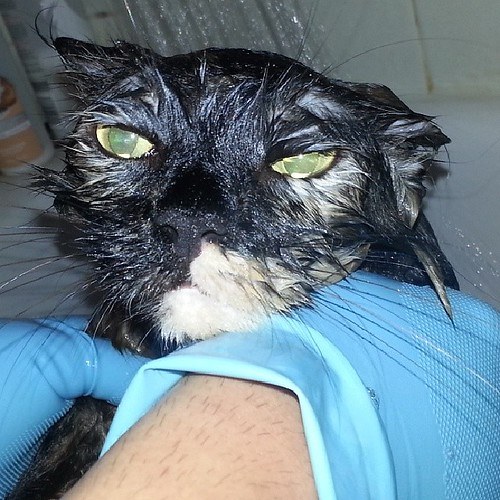
- Cotton balls for cleaning ears or for soaking up extra water or shampoo. Keep everything out of the ear canal to prevent infections. Never use a Q-tip inside the cat’s ear — you may cause damage.
- You may want to use gloves to protect your own skin.
- Gentle, approved cat shampoo
- Provide a non-skid surface to prevent any slipping
- Small pitcher to use to pour water over cat
- Treats — calming substances quite helpful
- Plenty of towels
Before the bath, these pointers can be helpful:
1) Brush the hair well to ensure untangling of fur
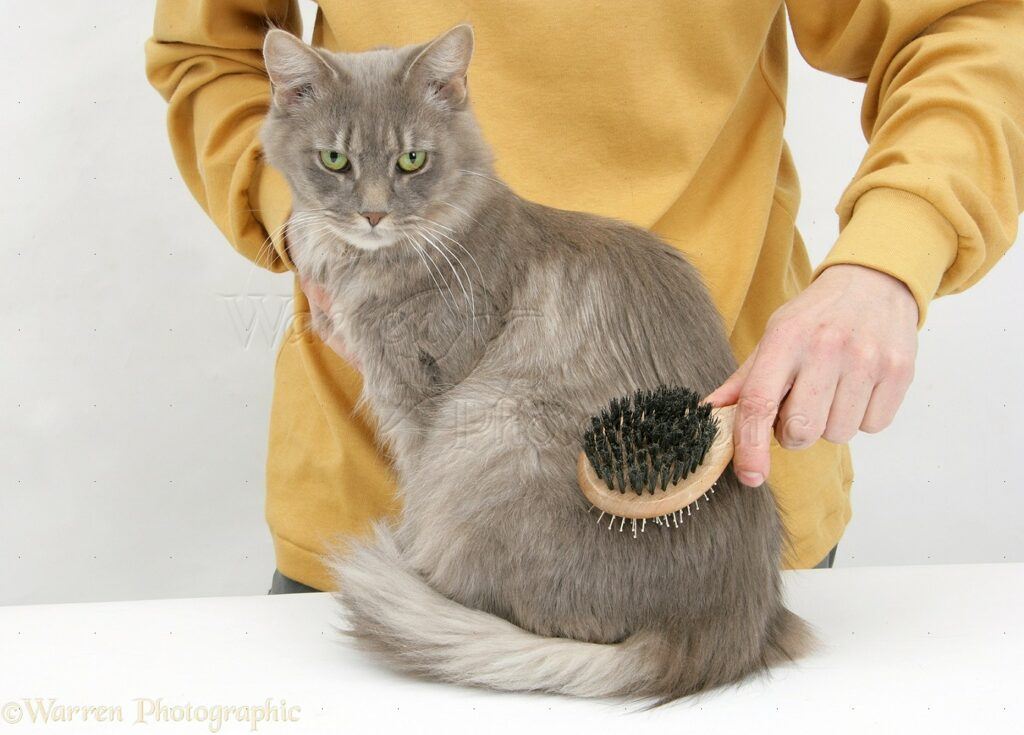
2) Trim the toenails (best to do that the day before.) Trimmed toenails will minimize the chances that you will receive scratches during the process.
3) Choose a time when kitty seems relaxed and a bit less energetic. After a meal or after play-time might work best.
4) Calm them ahead of time (treats help.)
5) Make sure to get a warm — not hot — bath, and don’t get the water higher than the cat’s tummy.
6) Have the towels ready before the bath. It will keep the mess more contained.
7) Prepare a non-sticking surface. It might just involve a mat in the tub.
What Container Will You Use?
One good advantage of the bathtub is that you can close the door, so kitty becomes less likely to escape. If you feel the tub is too big, put a small container, such as a baby tub, in the bathtub, and then fill to kitty’s chin with warm water.
If you hold him and lower him into warm water, the heat may help him relax.
Here is an excellent video about the bath process:
About The Water
Run the water after the cat is in the tub. You will upset the cat less this way than by putting him in standing water. Check temperature carefully — warm, but not hot.
Hold the cat firmly and remain calm.
It can also prove quite helpful to have an assistant.
If you are using a sprayer, direct it to the side of the sink or tub, and make whatever adjustments you need before the spray hits the cat.
Start on kitty’s backside; them move up the back toward the front legs. Though you don’t want the water too forceful, it has to get through the hair to the skin.
Move up the back toward the front legs. When working on the front end, cup the cat’s chin with your free hand. This will keep the spray out of their face.
Keep your supplies all laid out in easy reach, so you don’t have to look for them.
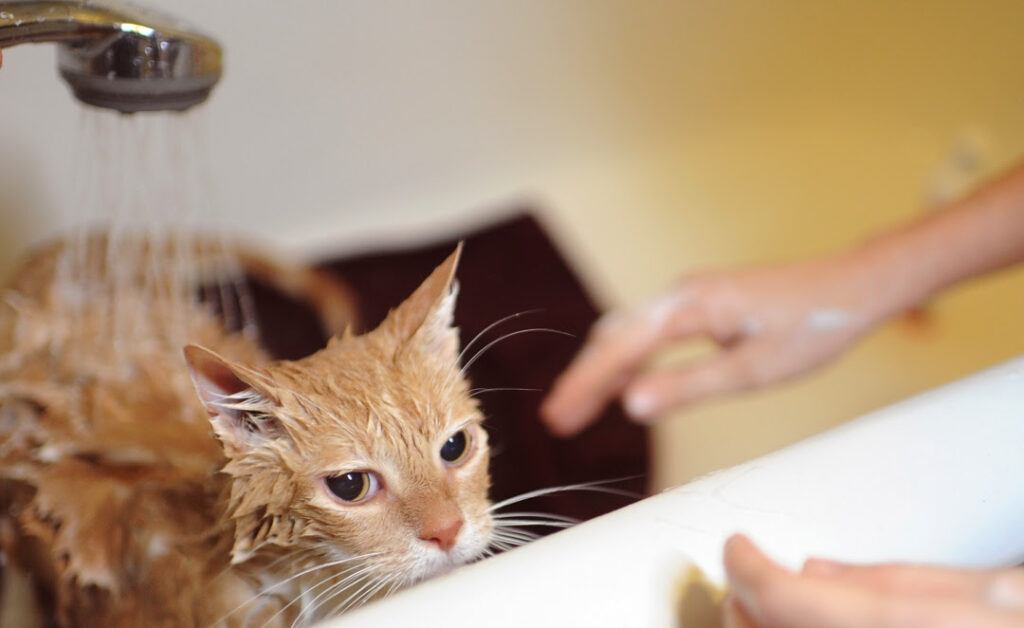
Be sure to get all areas of the cat if he will let you, including stomach and tail. Make sure to rinse kitty well; then dry him as quickly as possible, so he doesn’t get cold. Once you’ve soaked up the majority of the water, the cat can then air dry.
Though bathing may not weigh in as your cat’s favorite thing, you and the cat can get through the experience without too much fuss. Sometimes a bath is necessary. Stay calm, keep kitty as calm as possible, and know that the bath can be a very beneficial thing for kitty’s health.
References I used for post: fveap.org/how-often-should-you-bathe-a-cat/ vetmed.tamu.edu/news/pet-talk/cat-bath/ ccspca.com/blog-spca/education/bathing-a-cat/ petful.com/grooming/how-to-give-a-cat-a-bath/

